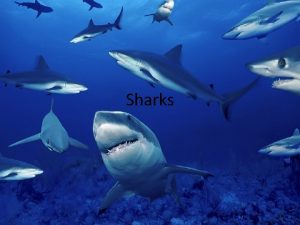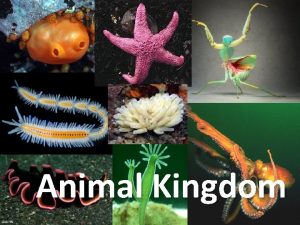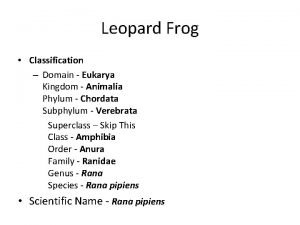Sharks Shark Ray Classification Domain Eukarya Kingdom Animalia
















- Slides: 16

Sharks!

Shark & Ray Classification �Domain: Eukarya Kingdom: Animalia ▪ Phlym: Chordata ▪ Subphylum: Vertebrata � Class: Chondroichthyes—sharks rays and all relatives �Subclass: Holocephali—Chimareras �Subclass: Elasmobranchii—Sharks and Rays

Basic Characteristics of Cartilaginous Fish � Class Chondrichthyes Includes sharks, rays, skates, and sawfish � Jawed fish � Lack a swim bladder � Skeletons made of cartilage (not bone)

Energy Savers � Though sharks are constantly swimming, they actually manage to do so without using much energy at all. � How do they do it? Cartilage is lighter than bone Large, oily livers keep them buoyant � Their energy saving techniques make them successful hunters—they do not have to eat as much, leaving them more energy to strike prey, and allows them to be quick and inconspicuous

Getting Lift �The shape of a shark’s fin and a ray’s body act like wings and give them lift �It allows them to glide through the water easier

Scaly Skin �Scales called denticles cover the body �They are very similar to shark teeth �Point towards the tail and reduces friction from water

Toothy Grin �“Conveyor belt” teeth that swing into place when old teeth are lost or need to be replaced

Sharky Sense �Heightened sense of smell �Lateral Lines—detect water motion and vibrations �Ampullae of Lorenzini detect electrical currents generated by muscles of animals (electroreception)

Baby Sharks �Eggs are fertilized internally using the male’s claspers to transfer sperm from male to female sharks. �The claspers are paired copulatory organs found at the base of the pelvic fins. �Fertilized eggs are produced and… Some are released into the water Others hatch in the mother’s body and they give live birth

3 ways sharks give birth � Oviparous—Species that lay eggs that mature and hatch outside of the body like birds � Viviparous—Give birth to live young � Ovoviviparous—Sharks have eggs that hatch and develop within the mother’s body (so she give produces eggs, but give birth to live young. � **Intrauterine Cannibalism** Some baby sharks eat all of their brother and sisters in the womb so that only 1 baby shark is born.

Conservation Concerns �Sharks are animals that mature later and produce fewer offspring �Therefore populations are easily affected by hunting

Hunters of the Hunters �The family Lamnidae = most dangerous predators of all of the chrondroichthyes Include mako sharks and great white sharks �Incite fear into humans and are therefore killed without limit— making humans the most dangerous predators in the ocean.

Truth Behind the Attacks �On average there are fewer than 10 fatal shark attacks a year �However, tens of thousands of sharks are killed each year �Sharks don’t kill any more than bees, mountain lions, and tigers �But if they do…

How to Survive

Mega Sharks �Whale shark (46 feet) �Basking shark (33 feet) �Megamouth shark (20 feet) �AND ALL ARE FILTER FEEDERS!

Super Rays �Manta Ray (26 feet) �FILTER FEEDER AS WELL!
 Domain eukarya kingdom animalia
Domain eukarya kingdom animalia Domain eukarya, kingdom animalia (or animal)
Domain eukarya, kingdom animalia (or animal) All vertebrate animals are in domain
All vertebrate animals are in domain Coelom
Coelom Great white shark versus hammerhead shark
Great white shark versus hammerhead shark Is fungi in the eukarya domain
Is fungi in the eukarya domain Domain of kingdom protista
Domain of kingdom protista Plantae domain
Plantae domain Fungi domain
Fungi domain Domain eukarya kingdom fungi
Domain eukarya kingdom fungi Domain vs kingdom
Domain vs kingdom Old kingdom middle kingdom new kingdom
Old kingdom middle kingdom new kingdom Old kingdom middle kingdom new kingdom
Old kingdom middle kingdom new kingdom Youtube egypt
Youtube egypt Capital of egypt during the old kingdom
Capital of egypt during the old kingdom Sharks classification
Sharks classification Thresher shark kingdom
Thresher shark kingdom



























